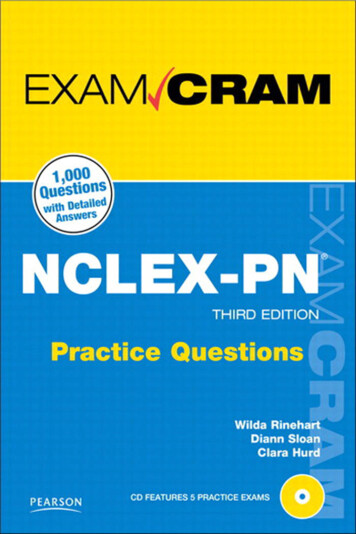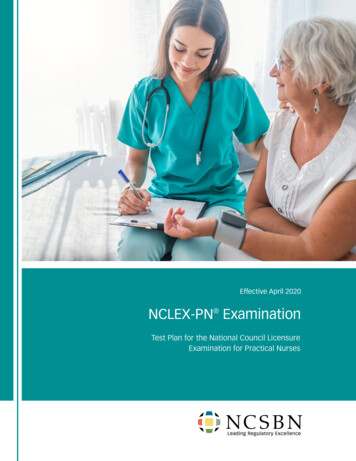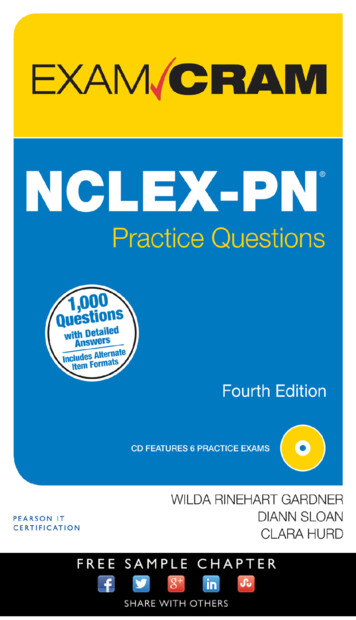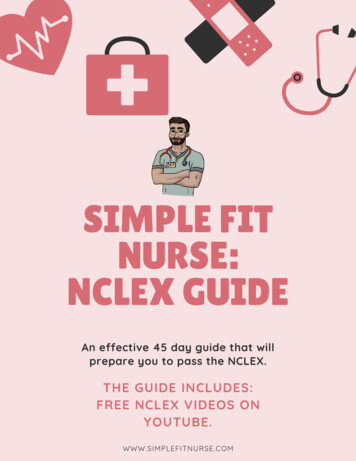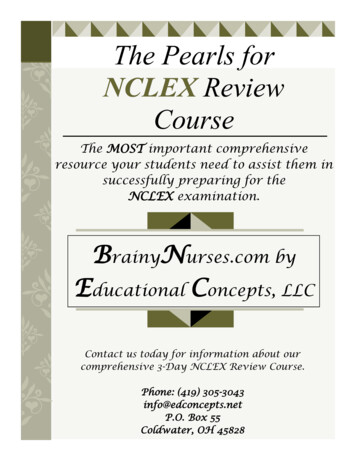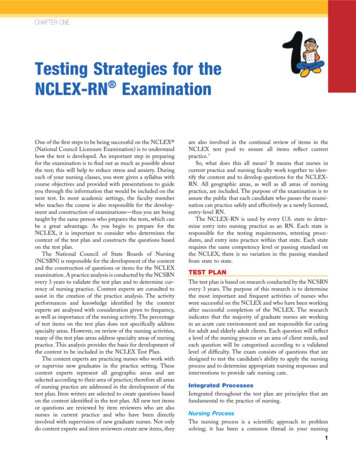
Transcription
CHAPTER ONETesting Strategies for theNCLEX-RN ExaminationOne of the first steps to be being successful on the NCLEX (National Council Licensure Examination) is to understandhow the test is developed. An important step in preparingfor the examination is to find out as much as possible aboutthe test; this will help to reduce stress and anxiety. Duringeach of your nursing classes, you were given a syllabus withcourse objectives and provided with presentations to guideyou through the information that would be included on thenext test. In most academic settings, the faculty memberwho teaches the course is also responsible for the development and construction of examinations—thus you are beingtaught by the same person who prepares the tests, which canbe a great advantage. As you begin to prepare for theNCLEX, it is important to consider who determines thecontent of the test plan and constructs the questions basedon the test plan.The National Council of State Boards of Nursing(NCSBN) is responsible for the development of the contentand the construction of questions or items for the NCLEXexamination. A practice analysis is conducted by the NCSBNevery 3 years to validate the test plan and to determine currency of nursing practice. Content experts are consulted toassist in the creation of the practice analysis. The activityperformances and knowledge identified by the contentexperts are analyzed with consideration given to frequency,as well as importance of the nursing activity. The percentageof test items on the test plan does not specifically addressspecialty areas. However, on review of the nursing activities,many of the test plan areas address specialty areas of nursingpractice. This analysis provides the basis for devel opment ofthe content to be included in the NCLEX Test Plan.The content experts are practicing nurses who work withor supervise new graduates in the practice setting. Thesecontent experts represent all geographic areas and areselected according to their area of practice; therefore all areasof nursing practice are addressed in the development of thetest plan. Item writers are selected to create questions basedon the content identified in the test plan. All new test itemsor questions are reviewed by item reviewers who are alsonurses in current practice and who have been directlyinvolved with supervision of new graduate nurses. Not onlydo content experts and item reviewers create new items, theyare also involved in the continual review of items in theNCLEX test pool to ensure all items reflect currentpractice.1So, what does this all mean? It means that nurses incurrent practice and nursing faculty work together to identify the content and to develop questions for the NCLEXRN. All geographic areas, as well as all areas of nursingpractice, are included. The purpose of the examination is toassure the public that each candidate who passes the examination can practice safely and effectively as a newly licensed,entry-level RN.The NCLEX-RN is used by every U.S. state to determine entry into nursing practice as an RN. Each state isresponsible for the testing requirements, retesting procedures, and entry into practice within that state. Each staterequires the same competency level or passing standard onthe NCLEX; there is no variation in the passing standardfrom state to state.TEST PLANThe test plan is based on research conducted by the NCSBNevery 3 years. The purpose of this research is to determinethe most important and frequent activities of nurses whowere successful on the NCLEX and who have been workingafter successful completion of the NCLEX. The researchindicates that the majority of graduate nurses are workingin an acute care environment and are responsible for caringfor adult and elderly adult clients. Each question will reflecta level of the nursing process or an area of client needs, andeach question will be categorized according to a validatedlevel of difficulty. The exam consists of questions that aredesigned to test the candidate’s ability to apply the nursingprocess and to determine appropriate nursing responses andinterventions to provide safe nursing care.Integrated ProcessesIntegrated throughout the test plan are principles that arefundamental to the practice of nursing.Nursing ProcessThe nursing process is a scientific approach to problemsolving; it has been a common thread in your nursing1
2CHAPTER 1Testing Strategies for the NCLEX-RN Examinationcurriculum since the beginning of school. There is nothingnew about the nursing process on the NCLEX. Assessmentdata are obtained, analysis of those data occurs, a plan isformulated, nursing actions are implemented, and the resultsof that intervention are evaluated. It is important to keepthe steps of the nursing process in mind when you are critically evaluating an NCLEX question.CaringThe interaction of the client and the nurse occurs in anatmosphere of mutual respect and trust. To achieve thedesired outcome, the nurse provides hope, support, andcompassion to the client.Communication and DocumentationEvents and activities—both verbal and nonverbal—thatinvolve the client, the client’s significant others, and thehealth care team are documented in handwritten or electronic records. These records reflect quality and accountability in the provision of client care. Principles ofdocumentation and provision of client confidentiality areimportant considerations in any area of nursing practice.Table 1-1Teaching and LearningNurses provide or facilitate knowledge, skills, and attitudesthat promote a change in clients’ behavior through teachingand learning. Nurses provide education to clients and totheir significant others in a variety of settings. Identifyingcritical learning needs for clients and their significant othersand providing information in a manner that promotes thehealth and safety of clients are important across all levels ofnursing practice.2Areas of Client NeedsThe National Council Examination Committee has identified four primary areas of client needs, which provide astructure to define nursing actions and competencies acrossall practice settings and for all clients. These areas reflect anintegrated approach to the testing content; no predetermined number of questions or percentage of questionspertain to any particular area of practice (e.g., medicalsurgical, pediatric, obstetric).Table 1-1 lists the areas of client needs, along withthe subcategories and the specific percentages associatedwith each subcategory. The range of percentages for eachNCLEX-RN TEST PLAN—EFFECTIVE APRIL 2010 TO APRIL 2013*Safe and Effective Care EnvironmentManagement of Care (16%-22%)Safety and Infection Control (8%-14%)Concepts of management of nursing care—supervision, delegation, establishing prioritiesin client care; legal and ethical responsibilities; client rights; confidentialityPrevention of errors and accidents, implementation of standard precautions, asepsis, useof restraints, disaster planning, handling hazardous materialsHealth Promotion and Maintenance (6%-12%)Aging process and developmental stages, lifestyle choices, high-risk behaviors; principles of learning and teaching; ante/intra/postpartumand newborn; health promotion and disease prevention, techniques of physical assessmentPsychosocial Integrity (6%-12%)Mental health concepts and interventions, end-of-life care, grief and loss, sensory and perceptual alterations, religious and spiritualinfluences; behavioral intervention/crisis intervention, chemical dependency, abuse and neglect, therapeutic communicationPhysiologic IntegrityBasic Care and Comfort (6%-12%)Pharmacologic and Parenteral Therapies(13%-19%)Reduction of Risk Potential (10%-16%)Physiologic Adaptation (11%-17%)Assistive devices, mobility, nutrition, personal hygiene, elimination, nonpharmacologiccomfort measuresMedication administration; expected medication actions, adverse effects/contraindication;nursing implications; dosage calculation; blood administration, parenteral/IV therapy,central venous access devices, pain control, parenteral nutritionPathophysiology, nursing implications for and nursing care to minimize potentialcomplications of diagnostic tests/procedures/surgery; potential for alterations in bodysystems (tubes, pacemakers, hyper/hypoglycemia, specimens, bleeding, immobility,wounds, positions); laboratory values; changes in and/or abnormal vital signs; systemspecific assessmentsPathophysiology/alterations in body systems: fluid and electrolyte imbalances,hemodynamics, medical emergencies (CPR, airway, hemorrhage), unexpectedresponse to therapies (seizures, changes in vital signs); nursing management of illnessAdapted from the NCLEX-RN Test Plan for the National Council Licensure Examination for Registered Nurses, Chicago, 2009, National Council of StateBoards of Nursing.*Test plan information is presented as examples only and is not intended to be a complete or thorough representation of information included in anyspecific category.
CHAPTER 1 Testing Strategies for the NCLEX-RN Examinationcategory reflects how important that area is on the testplan. Management of care, pharmacologic and parenteraltherapies, and reduction of risk potential are the subcategories with the highest emphasis on the test plan.2 Whenyou are studying for the NCLEX, these are concepts thatshould be identified across the scope of nursing practice.This table has been adapted and summarized; it does notreflect the entire test plan content. The National Council’sDetailed Test Plan for the NCLEX-RN may be obtainedfrom the NCSBN, Inc. (www.ncsbn.org). What was greatnew information in last month’s nursing journals will notbe immediately reflected on the NCLEX. New informationor new practices must be established as a standard of practiceacross the nation before being included on the NCLEX.Throughout this book are ALERT boxes that call yourattention to areas of the test plan. Pay attention to theseboxes and think about how each concept or principle canapply to different types of clients.ALERT The NCLEX-RN is a test that requires utilization of thenursing process and application of nursing concepts andprinciples across the life span.As client conditions or nursing principles are presented,the NURSING PRIORITY boxes call your attention tocritical information regarding a client with a specific condition or situation being presented.NURSING PRIORITY This is critical information to considerin providing safe nursing care for a client with a specific problem.Classification of QuestionsThe majority of questions on the NCLEX are written atthe level of application or higher level of cognitive ability.This means a candidate must have the knowledge andunderstand concepts to be able to apply the nursing processto the client situation presented in the question. NCLEXquestions are based on critical thinking concepts that demonstrate a candidate’s ability to make decisions and solveproblems. NCLEX questions are not fact, recall, or memory-level questions. Nurses who have taken the NCLEXhave stated that the NCLEX questions were not like anyquestions they had on nursing school examinations; however,the nursing content and principles needed to determine theanswer were provided in their nursing school curriculum.The questions and answers have been thoroughly researchedand validated. The standardization of information is important because the NCLEX is administered nationwide todetermine entry level into nursing practice. This ensuresthat regional differences in nursing care will not be a factorin the exam.All questions presented to a candidate taking the NCLEXhave been developed according to the test plan and theintegrated processes fundamental to nursing practice andhave been categorized according to their level of difficulty.The questions have been researched and documented aspertaining to entry-level nursing behaviors.2,33WHAT IS COMPUTERADAPTIVE TESTING?Computer adaptive testing provides a method for generatingan examination according to each candidate’s ability. Eachtime a candidate answers a question, the computer thenselects the next question based on the candidate’s answer tothe previous question. The examination continues to presenttest items based on the test plan and identified level of difficulty and provides an opportunity for each candidate todemonstrate competency. The NCLEX-RN is graded in amanner different from the grading of conventional schoolexams. A candidate’s score is not based on the number ofquestions answered correctly, but rather on the standard ofcompetency as established by the NCSBN (Figure 1-1).A test bank of questions is loaded into the candidate’scomputer at the beginning of the examination. Differentcandidates receive different sets of questions, but all testbanks contain questions that are developed according to thesame test plan. For example, standard precautions are a critical element of the test plan. Many situations and clients canbe presented to test this concept: one candidate may have aquestion based on standard precautions required for a clientin labor; someone else, a situation with implications for aclient with a respiratory problem; and still someone else, asituation involving a newborn. All the questions are different, but they are all based on the test plan’s critical elementof standard precautions.The questions to be presented to the candidate are determined by the candidate’s response to the previous questions.When a question is answered correctly, the next questionpresented to the candidate may have a higher level of difficulty. The more higher-level questions a candidate answerscorrectly, the closer he or she is to passing (Figure 1-2). Acandidate cannot skip questions or go back to previouslyanswered questions. As the examination progresses, it isinteractively assembled. As questions are answered correctly,the next question is selected to test another area of the testplan, and it may be at a higher level of difficulty. When aquestion is a
NCLEX test pool to ensure all items reflect current practice.1 So, what does this all mean? It means that nurses in current practice and nursing faculty work together to iden-tify the content and to develop questions for the NCLEX-RN. All geographic areas, as well as all areas of nursing practice, are included. The purpose of the examination is to assure the public that each candidate who .File Size: 815KBPage Count: 22

